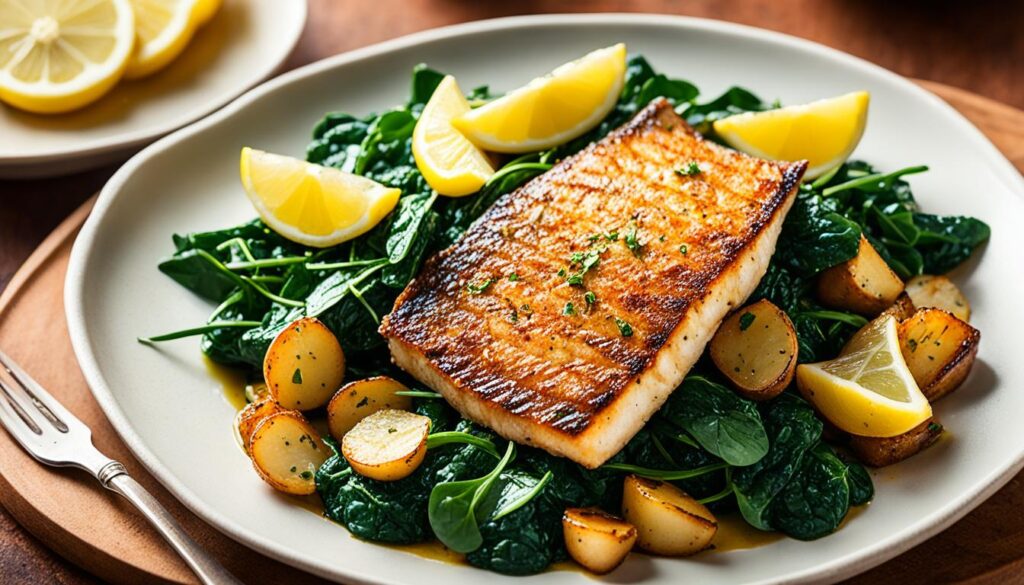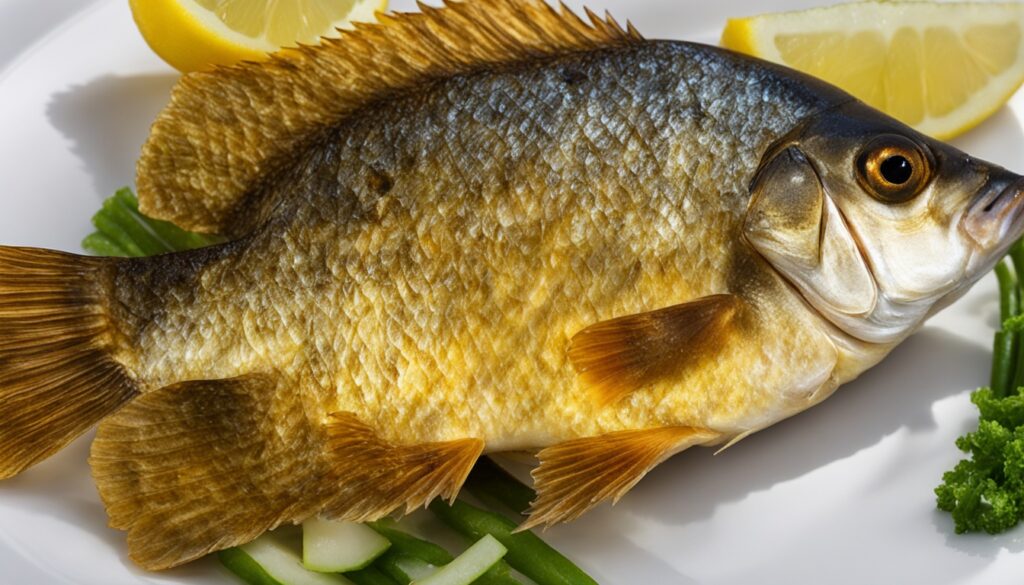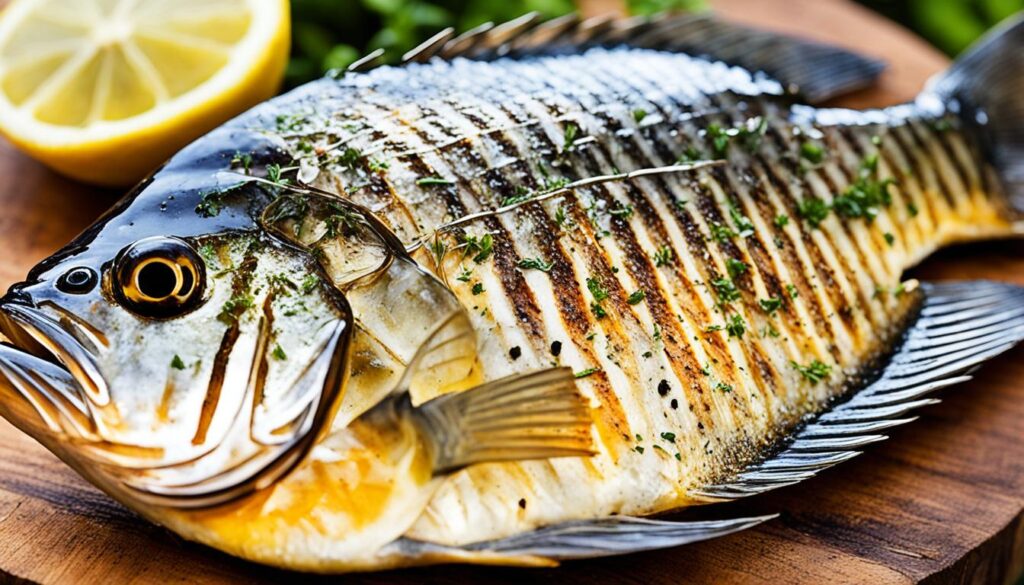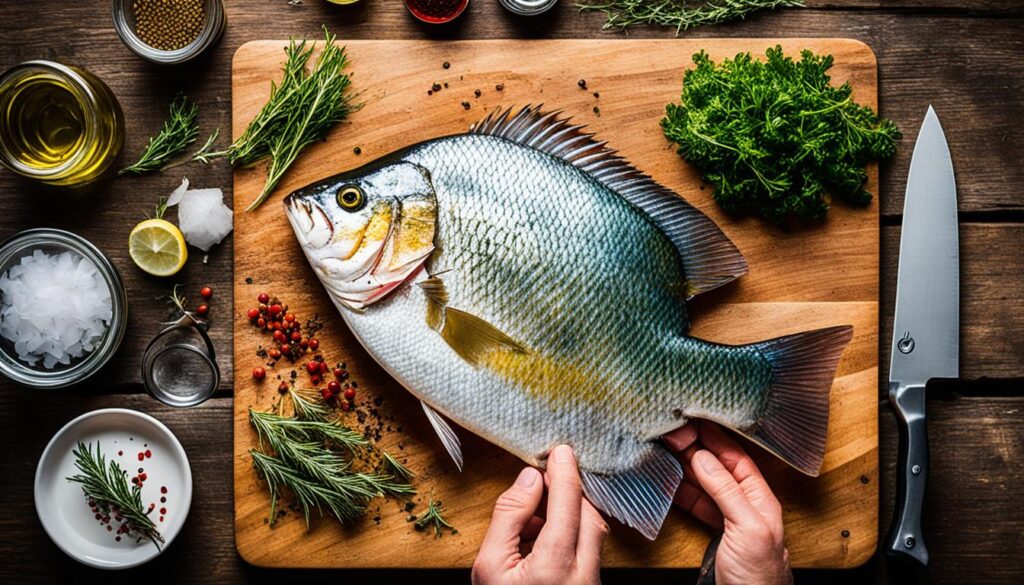Many of us recall the fun of summers spent fishing. We’d sit by farm ponds, casting out for bluegill. If you’re into fishing, you’ll know these tiny fish are a big deal. There are many ways to cook and enjoy them.
As a child, the author and their brother caught and cleaned bluegill. First, they’d slice off the head and pull out the guts. Then, they’d get rid of the scales using a spoon.
Their mom would then fry the fish, keeping the skin, bones, and tails on. Over time, the author got better at it. They learned to skin the fish and cut off small, sharp fins. Later, they could fillet the bluegill, taking out the bones.
Even now, the author finds joy in cooking bluegill. They sometimes leave the skin on. Or they may remove the skin and bones but keep the tail. Every dish they make has something special about it.
How you like your bluegill says a lot about you. Do you go for the crispy skin and crunchy fins, or the tender fillets? There’s no right or wrong way. Just keep trying different techniques until you find what you love.
With a bit of creativity, you can turn bluegill into meals that everyone will rave about. Practice and explore. Soon, you may have a bluegill dish that’s your family’s favorite.
Key Takeaways
- Bluegill can be prepared in a variety of ways, from frying with the skin and bones intact to creating delicate fillets.
- Each preparation method offers unique flavors and textures, so it’s important to experiment to find your personal preference.
- Proper handling and storage of bluegill is crucial to maintaining the fish’s optimal freshness and flavor.
- Bluegill is a versatile and nutritious freshwater fish that can be incorporated into a variety of dishes.
- Successful bluegill fishing requires the right bait, lures, and knowledge of prime fishing spots and seasons.
What’s the Best Way to Eat a Bluegill?
Bluegill is a favorite in the world of freshwater bluegill recipes. It’s not just exciting to catch but also a tasty meal. Many ways exist to bluegill cooking methods and enjoy it. The author’s family has tried various bluegill preparation techniques such as frying it as a whole or filleting it. Everyone picks their favorite, but there’s no wrong way to eat fried bluegill dish ideas, according to the author.
Bluegill stands out for its mild, tender flavor, letting it work well in different dishes. Its bluegill flavor profile is sweet and a little nutty, not too strong. This makes it great with many seasonings and ways of cooking. Besides tasting good, bluegill is healthy too. It’s a lean, protein-rich fish full of omega-3s, vitamins, and minerals, so it’s a great pick for your diet.
If catching your own bluegill fishing tips sounds fun, there are some tips for success. The author found that using worms and grasshoppers is good for getting bluegill’s attention. Bluegill can be caught in different places like farm ponds and rivers, mostly in warm weather like summer. Following these hints can help you bring home some tasty bluegill.

To keep your bluegill tasting great, be careful how you handle it after catching. The author says to put caught bluegill on ice right away, even if you’re not cooking it immediately. This stops the fish from tasting unpleasantly “muddy” or “fatty”. Cold fish are also simpler to clean, the author says, so chilling them helps with this step too.
| Preparation Method | Pros | Cons |
|---|---|---|
| Skin-On and Scaled | Easiest method, preserves natural flavor and texture | Some may not enjoy the taste and texture of the skin |
| Skinned and Bone-In | Preserves crunchy texture, still has a bold flavor | Potential for bones, which can be a concern for younger diners |
| Boneless Fillets | Eliminates bone concerns, allows for quick cooking | Most time-consuming preparation method |
Fried Bluegill Delights
Frying bluegill is a top choice for many. It creates a meal with a crispy outside and a tender inside. This makes every bite delicious. To make it, you clean the fillets, then dip them in eggs and milk. After that, cover them in breading and fry until golden-brown.
Classic Fried Bluegill Recipe
Follow these simple steps to cook fried bluegill:
- Rinse and pat dry the bluegill fillets, ensuring they are free of any skin or bones.
- In a shallow bowl, whisk together a few beaten eggs and a splash of milk to create a dipping mixture.
- In a separate bowl, combine a blend of all-purpose flour, cornmeal, salt, pepper, and any other desired seasonings to create the breading.
- Dip the bluegill fillets into the egg mixture, then dredge them in the seasoned breading, coating them evenly on all sides.
- Heat a generous amount of vegetable oil in a large skillet over medium-high heat.
- Carefully add the breaded bluegill fillets to the hot oil and fry until they reach a crispy, golden-brown perfection, typically 3-4 minutes per side.
- Drain the fried bluegill on a paper towel-lined plate and serve hot, garnished with a sprinkle of lemon juice or your favorite dipping sauce.
Crispy and Crunchy Tails
The crunchy tails are a special treat in fried bluegill. They add a lot of crispy fun to the meal. The crunchy tails compliment the soft fillets very well, like a fine dish.

Grilled Bluegill: Smoky Flavor Perfection
Grilling bluegill gives it a smoky, delicious taste. This method adds depth to the fish, making eating it delightful. To make grilled bluegill amazing, focus on marinating it and using the right grilling methods.
Marinating for Maximum Flavor
Start by making a tasty marinade for the bluegill. Mix olive oil, lemon juice, garlic, and herbs. Let the fish sit in the marinade for 30 minutes. This makes the fish soak in the zesty and flavorful blend before grilling.
Grilling Techniques for Perfect Doneness
After the marinating, grill the fillets. Heat the grill to medium-high and oil the grates. Put the fillets on and cook for 3-4 minutes per side. The fish should be opaque and flake easily. This ensures the bluegill is smoky, juicy, and cooked perfectly.

Following these steps makes your bluegill a culinary masterpiece. It will be full of smoky flavor and cooked just right. Whether you’re a cooking pro or new to bluegill recipes, everyone will love this grilled dish.
Bluegill Tacos: A Zesty Twist
Bluegill tacos offer a fun way to enjoy this fish. Bluegill’s mild flavor matches well with the spicy taco twist. The result is a meal that’s tasty and sticks in your memory.
First, cut bluegill fillets into small pieces. Then, season them with taco spices and sauté. Next, put in warm corn tortillas. Top with cabbage, salsa, avocado, and lime. This mix of soft bluegill and lively toppings makes a delicious dish.
If you want to try a new dish with bluegill, tacos are a great pick. You can play with preparation methods and toppings. This lets you discover the best mix of bluegill and Mexican flavors.
Bluegill Ceviche: Light and Refreshing
Ceviche is a light and refreshing way to eat bluegill. The bluegill fillets are cut into small pieces. Then, they are marinated in a mix of lime juice and other citrus juices. This process makes the fish look cooked, even though it’s not. The result is a bright dish that highlights bluegill’s mild taste.
Citrus Marinade “Cooking” Method
To make ceviche, first, cut the bluegill fillets into small cubes or strips. Put them in a bowl and cover with lime juice. The lime juice will slowly ‘cook’ the fish.
As the fish ‘cooks,’ add diced tomatoes, onions, cilantro, and a little salt and pepper.
Serving Suggestions for Ceviche
Once the bluegill is marinated, it’s time to serve. Ceviche is great on tostadas or with tortilla chips. The tangy ceviche flavor works really well with the crispiness of the tostadas or chips.
This dish is perfect if you want something light and tasty. It’s also a fun twist to try with your bluegill catch.
Skinned or Scaled: Pros and Cons
Preparing bluegill offers various ways, each with pros and cons. Keeping the skin on and scaling it makes the process easy. However, some might not like the skin’s taste and feel. Another way is to skin the fish but keep the bones and tail. This keeps the fish crunchy but adds a bone risk, especially for kids.
Skin-On and Scaled
Leaving the skin on and scaling the bluegill is the easy way. It keeps the fish’s natural crunch and taste that many love. But, the skin might not taste good, especially if the fish is strong-flavored.
Skinned and Bone-In
Skinning the fish but keeping the bones and tail is a middle ground. It keeps the bluegill crunchy but still has bones. This might not be ideal for families with young kids. Handling bone-in fillets takes more care while eating.
Boneless Fillets
Making boneless fillets by filleting the bluegill is the simplest way. It takes more work but makes eating easier. Boneless fillets cook fast and avoid bone hazards.
The author’s family tried all three ways to prepare bluegill. They picked their favorites for texture, taste, and convenience. There’s no one “best” way to enjoy bluegill. It all depends on what you like best and what fits your dining style.
Bluegill Flavor Profile and Nutrition
Bluegill has a mild, delicate taste loved by many. It’s sweet and has a hint of nut. This flavor is gentle, making it work well with many dishes. You can fry, grill, or use it in tacos or ceviche. Its mild flavor lets it stand out in any dish.
Mild and Delicate Taste
Why is bluegill so popular? Its mild, sweet flavor adds to any meal. The sweet, nutty taste lets other flavors come to the front. This makes bluegill great for simple or fancy recipes. It’s perfect for those starting to eat more seafood.
Nutritional Benefits of Bluegill
Bluegill is not just tasty; it’s good for you too. With plenty of protein and omega-3s, it’s nutritious. Bluegill is also rich in vitamins and minerals. It’s a great option for nutrient-rich meals. And it’s very versatile, fitting into many recipes.
Bluegill Fishing Tips for Fresh Catch
If you love catching bluegill, knowing a few tips can make your fishing trip better. Knowing what bait and lures work best, along with the top fishing spots and seasons, can bring you a great haul. Bluegill fishing will be fun and rewarding with this advice.
Best Bait and Lures
From the author’s memories, worms and grasshoppers are great at catching bluegill. They are natural baits that the fish find very attractive. These make great choices, but you could also try small spinners and crankbaits if you prefer artificial lures.
Prime Fishing Spots and Seasons
Bluegill live in places like ponds, rivers, and lakes. Fishing is usually best in the summer, when they feed a lot and are easier to catch. It helps to know your local waters and when bluegill are most active to bring home plenty of fish.
Storing and Handling Bluegill
To get the best taste and texture from your bluegill, they must be stored and handled correctly. It’s crucial to put the fish on ice right away, even if you won’t cook them immediately. This stops the fish from getting a “muddy” or “fatty” taste.
The author also mentions that cold fish are simpler to prepare. When fish is chilled, skinning and filleting them is easier. This makes the cleaning process faster and helps keep the nutritional value intact.
Knowing the right way to prep and handle bluegill is key. With a little care and focus, you can make sure your bluegill meals are amazing every time.
FAQ
What are the best ways to prepare and enjoy bluegill?
Bluegill can be prepared in many tasty ways like frying, grilling, making tacos, or ceviche. Each method has its own good and bad points, based on the author’s family experiences.
How do you make classic fried bluegill?
Start by cleaning and filleting the bluegill fillets. This means taking off the skin and bones. Next, mix eggs with milk and dip the fillets. Coat them with a seasoned mix and fry in hot oil. The crunchy tails are often the best part.
What’s the best way to grill bluegill?
For grilling, marinate the fillets in olive oil, lemon juice, garlic, and herbs for 30 minutes. Then, grill for 3-4 minutes each side. Use the right marinating and grilling techniques ensures perfect cooking. Bluegill gets a great smoky taste this way.
How can you make bluegill tacos?
Making bluegill tacos is a fun idea. Cut the fillets into small pieces and season them with taco seasoning. Then, sauté the fish until it’s done. Serve in corn tortillas with cabbage, salsa, and avocado for a tasty meal.
What is the best way to prepare bluegill ceviche?
Ceviche is a light and tasty way to enjoy bluegill. Cut the fillets into small pieces and let them marinate in lime juice. The acid from the lime “cooks” the fish. Add in tomatoes, onions, and cilantro. Serve with tortilla chips or on tostadas as a tangy starter.
What are the pros and cons of different bluegill preparation methods?
Filleting the bluegill has its pros, but it takes the most time. It makes the fish boneless for quick cooking. Leaving the skin on is easy, but not everyone likes its taste. Skinning it and leaving the crunchy tail has its appeal. However, it poses a bone risk, especially for kids.
What is the flavor profile and nutritional value of bluegill?
Bluegill has a light, mild taste. It’s a flexible option for cooking. This fish is sweet, almost nutty, without being too strong. It goes well with various spices. Nutrition-wise, bluegill is lean and full of protein. It’s also a good source of omega-3, and vitamins.
What are some tips for catching and handling bluegill?
The author found worms and grasshoppers great for catching bluegill. They’re often found in ponds, rivers, and lakes. The best fishing time is summer. For the best taste, put the fish on ice right away. This keeps them fresh, even if you don’t cook them immediately.
